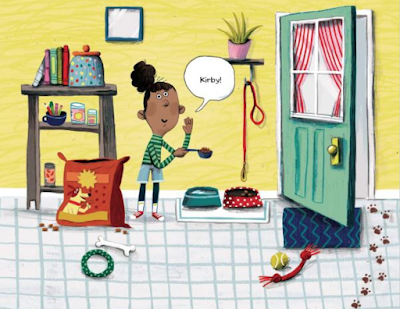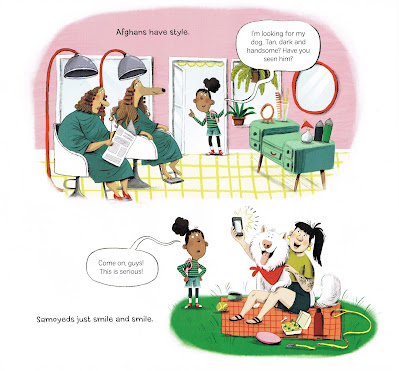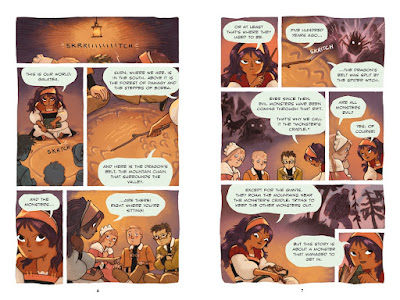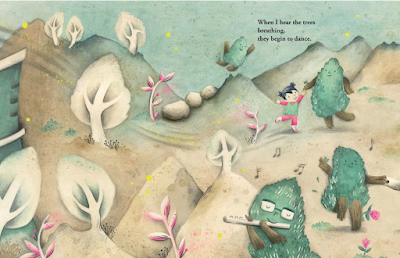Written by Jennifer McGrath
Illustrated by Kathryn Durst
Kids Can Press
978-1-5253-0340-1
32 pp.
Ages 3-7
May 2022
When Kirby, her pug, goes missing, this child searches all over town, inquiring of others with their own dogs, as to any sightings. There's Mrs. Gossman with her golden retriever and Mr. McCraig the crossing guard with his helpful border collie. Then there's Casey with his ball-playing lab and Jo and Jan with their Doberman. There are countless dogs and their people all over town and, while she politely asks for help finding her chubby pug with his macaroni-shaped tail, Kirby is out on the road causing mayhem for drivers and then the police and the community as a whole.
 |
From Pugs Cause Traffic James by Jennifer McGrath, illus. by Kathryn Durst
|
There are poodles and chihuahuas, huskies and terriers, German shepherds, afghans and basenjis. But no Kirby, the pug, who has left the comforts of his home to follow a butterfly.
 |
| From Pugs Cause Traffic James by Jennifer McGrath, illus. by Kathryn Durst |
And, oh, the chaos while Kirby plays with the butterfly, oblivious to everyone around him trying to avoid him and instead having collisions and dropping their loads and getting snarled in traffic. But, it's with that attention–in fact, Kirby becomes a bit of a celebrity–that the child is able to finally be reunited with her beloved pooch.
 |
| From Pugs Cause Traffic James by Jennifer McGrath, illus. by Kathryn Durst |
My, my, my! Kirby may be unaware of the pandemonium and subsequent distinction given to him–there is a sign "Pug 4 Prez" and pugarazzi wanting his pawtograph–but he has always been a star to his girl. His household toys, treats, food and sleeping accommodations suggest a well-loved dog, not unlike the plethora of other breeds that ride in cars with their people, play and work and offer companionship. So, while New Brunswick author Jennifer McGrath introduces young readers to many, many dog breeds and their characteristics, she puts her tongue firmly in cheek, makes a few puns, and lets us join Kirby on his adventure, ultimately a safe one, to be the playful rover of Pugs Cause Traffic Jams. Moreover, Jennifer McGrath shows us the absurdity of those who declare celebrity for trifling matters, with photographers, police, podcasters, news people and fans pursuing the latest trend without question. It's only the children who notice Kirby for the lost dog that he is.
While there's a lot of accuracy in Toronto artist Kathryn Durst's illustrations, easily distinguishing the various dog breeds with their colourings, temperaments and morphologies, she keeps the artwork playful and energized, suitable for a story of an AWOL dog who unknowingly creates havoc. As bold as Kirby's spirit for adventure are Kathryn Durst's art created in pencil and pencil crayon with digital graphic apps Procreate and Photoshop. The illustrations are striking in their colour and shape, offering semi-realism with cartoon sass.
For young readers and especially those who are dog-lovers, Pugs Cause Traffic Jams will make them think twice about dropping their guard around their audacious pets, especially those special pugs, but also recognize that celebrating their pets' uniqueness doesn't require the spotlight of social media. Just being their canine selves should be enough to afford love and attention.






















